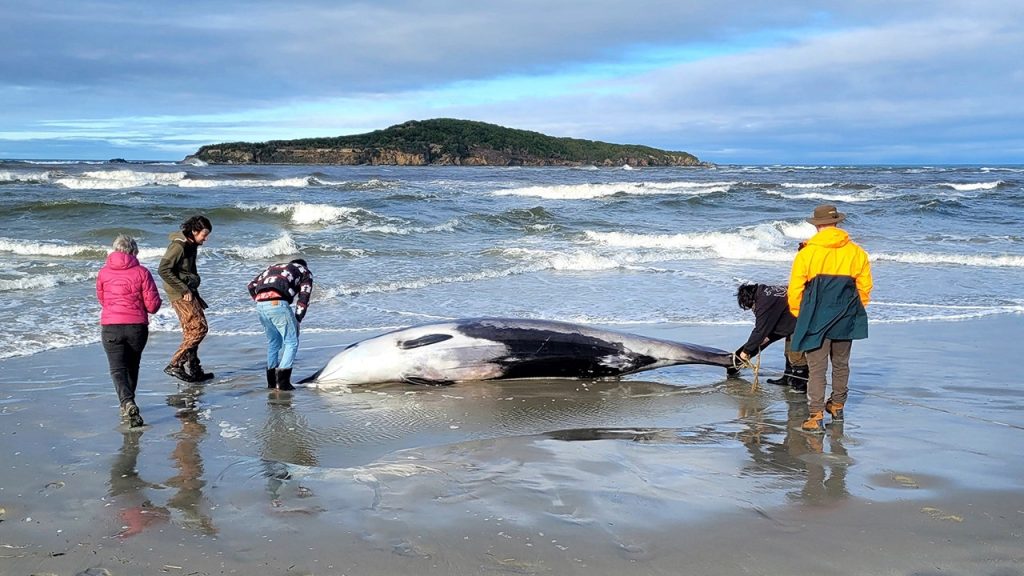The world’s rarest whale, the spade-toothed whale, yielded its secrets to science in a groundbreaking dissection following a tragic discovery. A near-perfectly preserved 5-meter male specimen washed ashore on a New Zealand beach in July, marking the first complete example of this elusive species ever recorded. The event was both a scientific windfall and a culturally significant moment for New Zealand, particularly for the local Māori people, who consider whales to be taonga, or precious treasures. This particular whale’s journey from the depths of the ocean to the laboratory became a testament to both scientific inquiry and cultural respect.
Scientists, led by New Zealand conservation agency beaked whale expert Anton van Helden, embarked on a meticulous examination of the whale at a research center near Dunedin. Their initial observations focused on the whale’s cause of death. A broken jaw and bruising around the head and neck indicated the likely culprit: head trauma. While the exact nature of the injury remains a mystery, the evidence suggests a forceful impact. This unfortunate demise, however, provided an unparalleled opportunity to delve into the biology of a creature barely glimpsed by human eyes. Prior to this discovery, only seven sightings of spade-toothed whales had been documented, none of which were of a living specimen.
The dissection revealed fascinating details about the whale’s digestive system, a subject previously unknown to science. Unlike other beaked whales, each with distinct stomach configurations, the spade-toothed whale possessed nine stomach chambers. The contents of these chambers revealed a diet primarily consisting of squid, along with the presence of parasitic worms. Another surprising revelation emerged in the form of tiny vestigial teeth embedded in the upper jaw. These small remnants offer a glimpse into the whale’s evolutionary history, illustrating a connection to ancestors with more developed dentition. This finding underscored the unique nature of this encounter and the potential for new insights into cetacean evolution.
Beyond the purely biological findings, the dissection itself was a remarkable collaborative effort. Scientists and curators worked hand-in-hand with the local Māori iwi, or tribe, integrating Indigenous knowledge and customs into every stage of the process. This partnership reflected a deep respect for Māori traditions and the cultural significance of the whale. The iwi will retain the whale’s jawbone and teeth, elements of deep symbolic importance, while the rest of the skeleton will be preserved and displayed in a museum. 3D printing technology will be employed to create replicas of the retained parts, ensuring both scientific access and cultural preservation.
The spade-toothed whale’s arrival on New Zealand’s shores is not an entirely isolated incident. New Zealand is a global hotspot for whale strandings, with over 5,000 documented cases since 1840. These events, while often tragic, offer valuable opportunities for scientific study and enhance understanding of these magnificent creatures. The history of spade-toothed whale discoveries is sparse. The first documented finding was in 1872 on New Zealand’s Pitt Island, followed by another discovery on an offshore island in the 1950s. A third skeletal discovery occurred on Chile’s Robinson Crusoe Island in 1986. This latest discovery represents a significant leap forward in our knowledge of the species.
The meticulous dissection of this rare whale has illuminated aspects of its biology, evolution, and cultural significance. The collaborative effort between scientists and the Māori people has not only advanced scientific knowledge but also exemplified a respectful approach to cultural heritage. While the whale’s death remains a mystery, its legacy promises to enrich our understanding of this enigmatic species and strengthen the bond between scientific inquiry and Indigenous wisdom. This unique event marks a milestone in cetacean research and stands as a testament to the importance of cross-cultural collaboration in unraveling the mysteries of the natural world.

